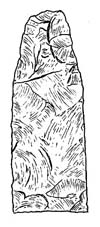 ***4Ac
***4Ac  ***4Ad
***4Ad 
back *****************VOLUME 18 page 6 ***************** next page
*****Another exciting find, comes from Parcelle 344 TAUNATERARA in the ANUA area on the west coast, 4 complete adzes were said to have been unearthed together by Tararoa while digging a hole to plant a banana shoot. These adzes are thought to have been only about 30 cm below the surface, and excavated from a zone which is about 50 meters from the present shoreline. This findspot gives some indication of an ancient deposit which apparently extends on to the next Parcelle 345 ANUA, where S. Schubert recovered, at a similar distance inland, a number of important early adzes (see Volume 16, Diagrams 16.9 and 16.10 and Appendix A).
*****One of the 4 is unique being an unusual type 4Ad . While the smallest adze in the group is a very rare 2Cd, this is quite similar to the specimen from ANUA (see Volume 16, Diagram 16.9 and Appendix A). This small adze I have illustrated in Diagram 18.7 and I suspect that this type will prove to be very a significant and helpful aid to identifying the source of this early Tubuai settlement (see also another ancient ANUA 2Cd example 452-386-2Cd Diagram 18.7a). While the 4A adzes retain some of their polish the 2Cd example appears a dull flat grey.
*****In Diagram 18.8 I have reproduced an important Tubuai adze recently recovered from Parcelle #332 TIIRUA this small adze is a true plano-convex form closely related to the Samoan Type Vb however the lightly pecked butt of the Tubuai form differentiates this example from the Samoan types. In the Comparative Diagram 18.8a I have reproduced (from a 1968 paper by Lawrence and Helen Birks) a Fijian Lapita adze from the Sigatoka Sand Dunes. This is a plano-convex form which is also closely related to the Samoan Type Vb and probably dates to around 500 BC or earlier. It is important to note that the Birks mention the presence of hammer dressing on two out of the three illustrated adzes recovered from Level 1. The Sigatoka example compares well with the TIIRUA adze however we see that there is a decided slope to the butt which is offset by a front that also slopes toward the cutting edge. This gives rise to a form which closely resembles a 4C adze from Wairau which Duff (1956, 183, Fig. 44) has selected as a Type model. The fact that this form exists as a separate identity is confirmed by a Marquesan example illustrated by Figueroa and Sanchez (1965, Fig. 74 a) and reproduced for comparative purposes here in Diagram 18.8c. The 4C adzes therefore differ from the Samoan Type Vb and can be shown to slowly evolve and intergrade with adzes which belong to type 4 and particularly my sub variety 4Ac (see also Comparative Diagram 18.8c).
*****Again I must submit the logical solution to explain the many variations within these small adzes. It appears as though very similar techniques were employed to manufacture these adze forms, techniques which probably changed little over the millenniums. A close inspection of the backs of these adzes reveals that they have been made the same way. The backs Koma type adzes of the Marquesas which were in production up to the contact period differ little from those seen in the Samoan Types VII, VI and Vb made thousands of years previously. While the backs remained the same the fronts must change to allow the development of various cutting edge forms. I submit that at any given period a number of different cutting edge forms were required, and that these were applied to preforms which were on the whole quite uniform. Therefore while there is a great similarity in the general size and shape of certain adzes the cutting edge form may be quite different. This is readily apparent when one compares the 2Cd adze illustrated in diagram 18.7, with the 4Cd in Diagram 18.8. both being exceptionally rare and ancient adzes, which probably derive from a similar early context.
*****Another observation concerning the variation in small adzes must be added here however, from the numerous examples of finished and unfinished specimens in the Tubuai collection, there appears a group of small shallow adzes that were probably manufactured very quickly and directly from well struck flakes and blades. The blanks probably being much like the Samoan Blank Type A (Leach 1990, 72, Figure 17). These adzes vary considerably due to the irregular and unpredictable nature of the flake. I suspect that even some of the shallow plano-convex forms such as the Samoan Type Va may derive directly from these flakes, many of which may have possessed suitably curved bulbar or natural surfaces.
Link to page 7***** page/link INDEX *****file INDEX*****Artifact/Diagram INDEX